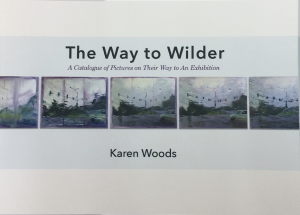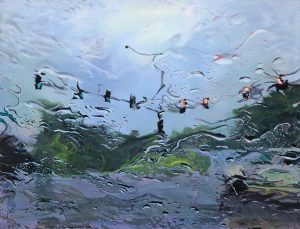The Way to Wilder (Karen Woods, 2020)

Seeing in the rain
I first met Karen Woods in May 2006 when Margie and I were invited to lead a weekend retreat at her church, All Saints Presbyterian, in Boise, ID. It was a lovely time. Karen showed us the little studio where she painted, and we wondered together over the glory of human creativity.
In 2015 Karen and her husband drove the thirty miles from Boise to Wilder, ID in a rainstorm. Karen snapped pictures through the car’s rain streaked windows and later turned them into a series of paintings. Her work is collected in a lovely full-color, large-format catalogue, The Way to Wilder. It is a journey into creativity. Karen’s paintings are beautiful, well crafted and multi-layered, and the catalogue is produced with the same level of care and creativity. It depicts not only finished works inspired by a road trip but also depicts them as works in progress, allowing us to catch a inside glimpse into her creative process.
The catalogue tells the story of a road trip, and a process for each work.

The layout of The Way to Wilder is simple. In two or four-page spreads the original photograph Karen took through the car window is displayed. Then a series of partially completed paintings are depicted leading to the finished work. Not being a visual artist, this invitation into her studio and imagination, her craft and process was like seeing behind a curtain that is usually drawn tightly to keep me out. The unfinished works are fascinating in their own right, and for each I wondered why she would do that… add that… sweep color there… make that change… and then I was looking at the finished piece… still wondering how she got there.
The Way to Wilder is a visual exposition of abstraction and realism. We’ve all been in cars during heavy downpours and so each image is realistic. And yet, in the swirling raindrops and streaks of water on the glass everything we see is distorted. Headlights are blurred, trees and passing cars simplified and imprecise. Street signs are elongated, in “Sweet Stop” a stop sign morphs into a candy on a stick. We know we are seeing ordinary things and that the distortion of the rain is natural. Yet the ordinary becomes strangely garbled. A reminder that abstraction is not an artistic conceit of modernity but a part of a good creation.
This vision is also a metaphor, for here truly we see through a glass darkly. We are not blinded, and the glass is not opaque, and yet our sight is subtly corrupted so that we are forced to struggle to make sense of what we see. We see, but in part. In “Medallion” we focus on a tree along the side of the road. More accurately, we focus and can’t quite get it into focus, and yet we know it is a tree. It is the streaks of water on the glass that are fully in focus, something we would likely never focus on intentionally as we rode along on the way to Wilder.
There is a lovely playfulness in these paintings coupled with a serious devotion to beauty in a broken world. I felt rather like a child without a care in the backseat looking out the windows as it rained, free to look and wonder, amused that a bit of water on glass can so transform our perspective.
The pandemic, civil unrest and political, economic uncertainty means art has added significance. Beauty is not an optional thing for human flourishing but essential to Christian faithfulness. Scripture speaks more of glory than beauty, an expansive term that embraces beauty but goes beyond it to remind us that we are not speaking of some abstract quality that we like in things and people; we are speaking of the stunning majesty of God.
The best way to enjoy The Way to Wilder would be to travel to Boise, stand before Karen’s exquisite collection and be glad. The second-best way is to order a copy of the book, pour a glass of wine and in an easy chair leisurely ride in a car during a rainstorm.
I recommend The Way to Wilder to you.
To order: Signed copies of The Way to Wilder can be ordered from Karen’s website.

